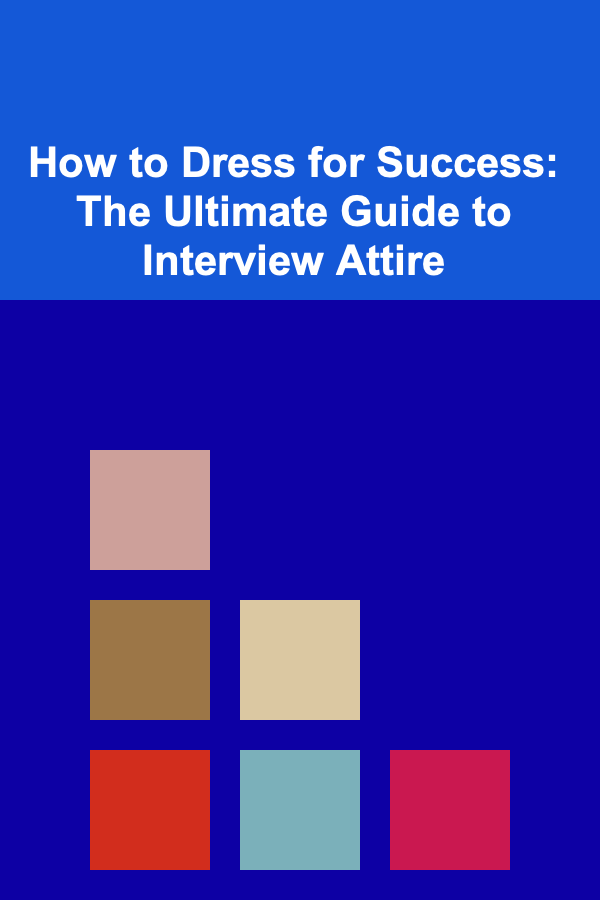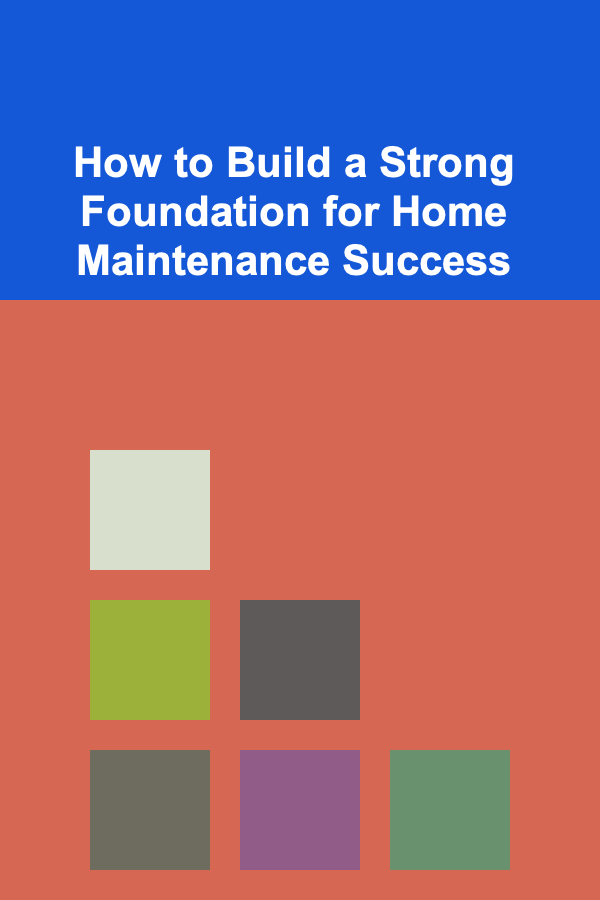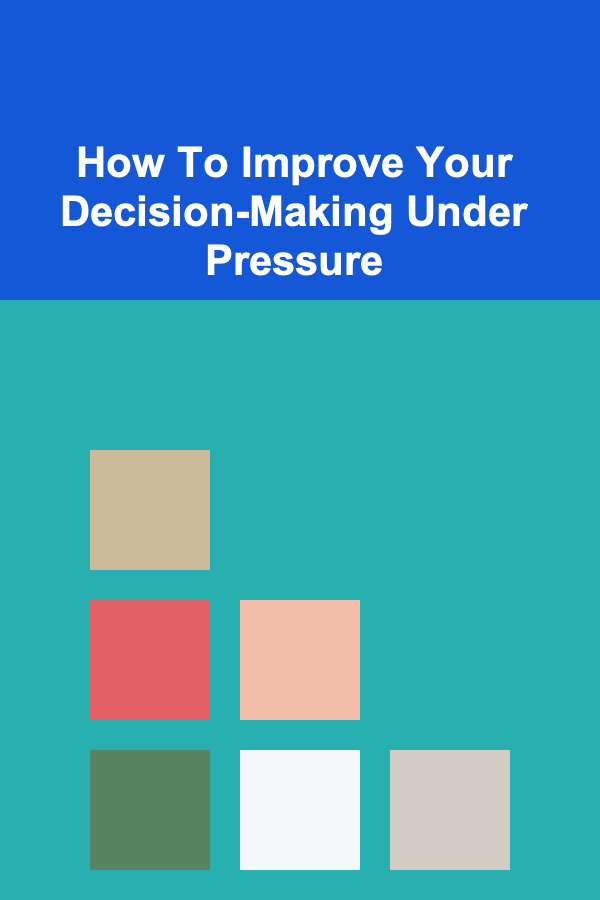
How to Dress for Success: The Ultimate Guide to Interview Attire
ebook include PDF & Audio bundle (Micro Guide)
$12.99$11.99
Limited Time Offer! Order within the next:

When it comes to securing your dream job, first impressions matter. While your resume and qualifications certainly play a significant role in the hiring process, how you present yourself physically---especially during the interview---can be equally important. The phrase "dress for success" is not just a catchy slogan; it's a strategy that can boost your confidence and help you stand out as a professional.
In this actionable guide, we'll delve deep into the importance of interview attire, explore what to wear for different types of interviews, and provide tips for ensuring your outfit works in your favor. Whether you're entering a corporate setting, a creative industry, or a tech startup, knowing how to dress appropriately for the interview is essential.
Why Interview Attire Matters
1. Creates a Positive First Impression
Your appearance speaks before you do. When you walk into an interview, your outfit is one of the first things your potential employer notices. A polished, professional look signals that you are serious about the job and respect the opportunity. The right attire reflects confidence, attention to detail, and an understanding of the company culture.
2. Demonstrates Your Respect for the Company
The effort you put into your appearance shows that you care about making a good impression and that you respect the company and the interview process. Employers want to hire individuals who show professionalism and can present themselves well, and dressing appropriately can make all the difference.
3. Boosts Your Confidence
Wearing the right outfit not only helps others see you as a professional, but it also impacts how you feel about yourself. Confidence is a key component of success in interviews. When you feel good about how you look, you're likely to perform better. A well-chosen outfit gives you the mental edge to approach the interview with poise.
General Guidelines for Interview Attire
While every industry and company may have its unique dress code, there are some universal principles that apply across the board. Here are some foundational guidelines to consider when preparing your interview outfit:
1. Know the Industry Norms
Understanding the nature of the industry you're applying to is crucial. Corporate industries like finance, law, and consulting generally have more formal dress codes, while creative industries, such as design and marketing, tend to have a more relaxed atmosphere. Tech startups might also embrace a more casual dress code, though it's still important to appear polished.
- Formal Industries: Opt for a suit or business attire. This could mean a suit and tie for men or a suit with a blouse or a conservative dress for women.
- Creative Fields: You have more flexibility. Think of adding a touch of individuality or personality to your outfit, but avoid being overly casual.
- Tech Startups: Business casual attire is often the norm, but you should still ensure that your outfit looks neat, well-fitted, and professional.
2. Fit is Key
No matter how nice the clothes are, if they don't fit well, they won't make the right impression. Ill-fitting clothes can make you appear sloppy and unprepared. Ensure your clothes are tailored to your body type, whether that's through custom tailoring or choosing the right size. Make sure your attire is neither too tight nor too loose.
- Tip: Pay special attention to your pants, jackets, and shirts. They should fit comfortably without being too tight or too baggy. If possible, have your clothes altered to ensure a professional look.
3. Stick to Classic Colors
While it can be tempting to wear bright or bold colors, sticking to classic, neutral tones is often a safer choice for an interview. Neutral colors exude professionalism and sophistication without being too distracting.
- Men's Attire: A dark suit (navy, charcoal, or black) paired with a light shirt (white, light blue) and a conservative tie is a classic, safe choice.
- Women's Attire: For women, dark-colored suits (navy, black, grey) with a blouse or a simple dress in muted tones are often best. You can add a pop of color with accessories, but make sure it's subtle.
4. Be Mindful of Accessories
Accessories can enhance your look but should be chosen with care. Avoid over-accessorizing or choosing items that are too flashy or loud. The goal is to look polished, not to draw attention to your accessories.
- Men: A simple watch, a belt that matches your shoes, and perhaps a tie clip are good choices.
- Women: Simple jewelry, like stud earrings or a small necklace, works well. Avoid chunky, flashy jewelry that can distract from the overall look.
5. Grooming is Essential
Your attire isn't the only aspect of your appearance that matters---grooming plays a vital role in creating a professional image. Ensure that your hair is neat, facial hair is well-trimmed (if applicable), nails are clean and trimmed, and any visible tattoos or piercings are kept in check if you're aiming for a formal environment.
- Men: A fresh shave or a neatly groomed beard is important. Avoid overly long or messy hair, and ensure it's styled neatly.
- Women: Hair should be clean and neatly styled. If you wear makeup, keep it natural and minimal. Ensure your nails are clean and trimmed.
Interview Attire for Different Types of Interviews
Understanding the dress code for specific industries and interview settings can help you choose the most appropriate outfit. Let's break down attire for some common job interview types.
1. Corporate/Professional Interviews
If you're interviewing for a position in a corporate setting, such as finance, law, or business consulting, formal attire is a must.
- Men: A suit and tie in a dark color (black, navy, charcoal) with a white or light-colored dress shirt. Polished, leather dress shoes, and a belt to match. Avoid loud patterns and bright colors.
- Women: A suit (pants or skirt) with a conservative blouse. Opt for a knee-length skirt or a well-tailored pant. Pair with closed-toe heels or professional flats. Keep accessories minimal and tasteful.
2. Creative Industry Interviews
Creative industries like advertising, graphic design, or fashion have a bit more room for personal expression while maintaining a professional look.
- Men: A business casual look works well here. You can wear a blazer with chinos or dress pants. Feel free to experiment with color in your shirts, but avoid looking too casual (e.g., no t-shirts or ripped jeans). Shoes should still be polished.
- Women: A smart dress or a well-tailored blazer and trousers or a skirt. Accessories can be a little bolder, but still maintain a professional appearance.
3. Tech/Startup Interviews
Tech companies and startups typically have a more laid-back atmosphere, but this doesn't mean you should dress too casually.
- Men: A business casual look is usually appropriate---think a button-up shirt with chinos or dark jeans. If you want to go a step further, wear a blazer or a lightweight sweater. Closed-toe shoes or smart sneakers are fine.
- Women: You can opt for a dress or smart blouse paired with trousers or a pencil skirt. Avoid wearing overly casual clothing such as jeans or overly casual shoes, but stylish, comfortable attire is acceptable.
4. Virtual Interview Attire
In the age of remote work, virtual interviews have become increasingly common. While the environment is more relaxed, it's still crucial to dress professionally.
- Men and Women: Choose an outfit that's appropriate for the company you're interviewing with, but ensure that it's professional from the waist up, as that's what will be visible on camera. Solid colors tend to look better on screen than busy patterns, and avoid overly bright or reflective clothing. Make sure your background is tidy and free of distractions.
Common Mistakes to Avoid
While it's important to know what to wear, it's equally important to be aware of the attire mistakes you should avoid:
1. Overdressing or Underdressing
Overdressing can make you seem out of touch with the company's culture, while underdressing can make you seem careless or unprofessional. Always aim to be slightly overdressed rather than underdressed, but be mindful of the industry standards.
2. Too Much Cologne/Perfume
Fragrances can be overwhelming and distracting during an interview. Use them sparingly, or avoid them altogether.
3. Visible Logos or Distracting Patterns
Avoid wearing clothing with large logos or overly busy patterns. Your attire should enhance your professionalism, not distract from it.
4. Wearing Uncomfortable Clothes
If your clothes are too tight, too loose, or uncomfortable, it will show in your body language. You won't be able to focus on the interview if you're adjusting your outfit constantly. Comfort is key.
Conclusion
Dressing for success is not just about following trends or fitting in---it's about presenting yourself in the best possible light. By understanding the expectations of the industry, knowing how to fit in without blending in, and ensuring your clothes are well-tailored, you can make a lasting impression at your interview. Remember, the right outfit can elevate your confidence, help you engage with your potential employer, and put you on the path to success. So, the next time you're preparing for an interview, take the time to dress thoughtfully and professionally---you'll be one step closer to landing the job of your dreams.

How to Build a Strong Foundation for Home Maintenance Success
Read More
How to Create Photography Courses for Aspiring Travel Photographers
Read More
How To Improve Your Decision-Making Under Pressure
Read More
How to Prevent Package Theft with Simple Home Security Measures
Read More
How to Transform Your Living Room with Budget-Friendly Ideas
Read More
How to Turn Your Bathroom into a Festive Holiday Escape
Read MoreOther Products

How to Build a Strong Foundation for Home Maintenance Success
Read More
How to Create Photography Courses for Aspiring Travel Photographers
Read More
How To Improve Your Decision-Making Under Pressure
Read More
How to Prevent Package Theft with Simple Home Security Measures
Read More
How to Transform Your Living Room with Budget-Friendly Ideas
Read More